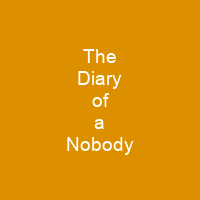The Diary of a Nobody: A Timeless Humor in the Victorian Era
Imagine stepping into the world of The Diary of a Nobody, where every page is filled with the mundane yet hilarious adventures of Charles Pooter and his family. This comic novel, penned by George and Weedon Grossmith, has become an enduring classic in English literature.
A Humorous Look at Victorian Life
First serialized in Punch magazine from 1888 to 1889, the diary follows Charles Pooter and his family through their daily struggles and social mishaps. Each entry is a delightful slice of life, capturing the essence of middle-class England during the late 19th century.
The Characters: A Cast of Comedians
Charles Pooter himself is a character who embodies both delusions of grandeur and social humiliations. His wife Caroline, at least eight years older than their son Lupin, adds another layer to the narrative with her unassuming charm. Together, they navigate the complexities of family life with humor and resilience.
From Serial to Bestseller
The diary’s journey from a serialized comic strip in Punch to a full-length book published in 1892 is nothing short of remarkable. Its initial reception was lukewarm, but over time, it has become recognized as a classic work of humor and satire.
A Literary Legacy
The success of The Diary of a Nobody helped establish the genre of humorous popular fiction. It influenced numerous adaptations in literature, film, and stage, cementing its place in the annals of English comedy.

Enduring Humor and Impact
Today, the legacy of The Diary of a Nobody lives on through its continued popularity. From audiobook versions to stage adaptations, it continues to resonate with readers and audiences alike. The term ‘Pooterism’ has even entered the lexicon, describing middle-class pretension and weakness.
Conclusion: The Diary of a Nobody is more than just a comic novel; it’s a mirror reflecting the quirks and challenges of Victorian life. Its enduring humor and insightful portrayal of everyday struggles make it a timeless classic, reminding us that sometimes, the most profound truths lie in the mundane details of our lives.
You want to know more about The Diary of a Nobody?
This page is based on the article The Diary of a Nobody published in Wikipedia (retrieved on November 30, 2024) and was automatically summarized using artificial intelligence.







